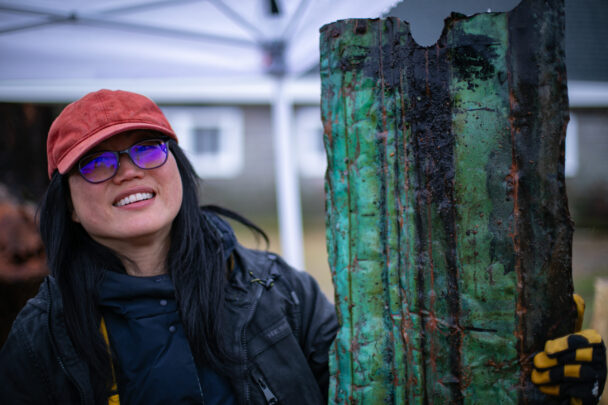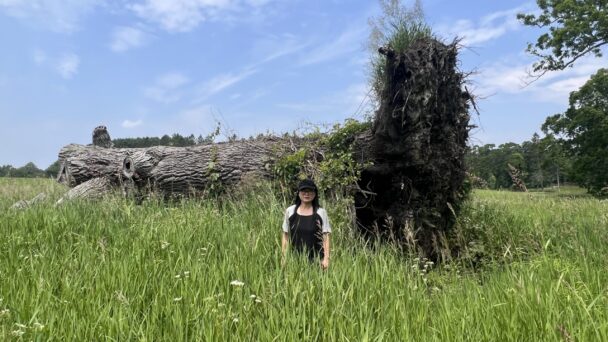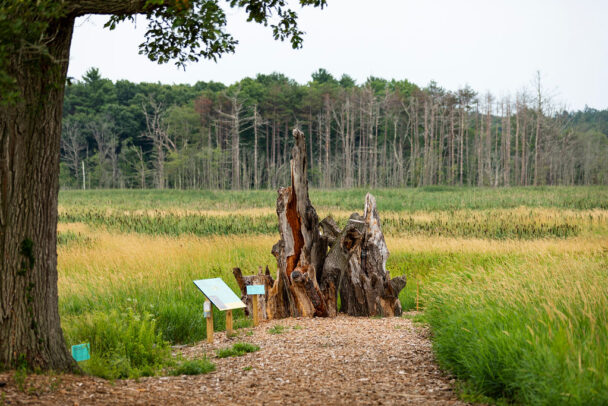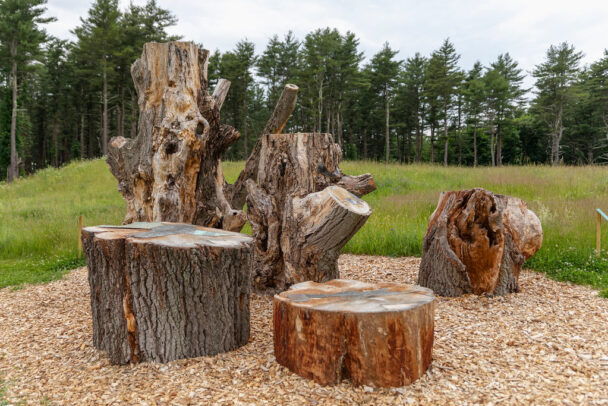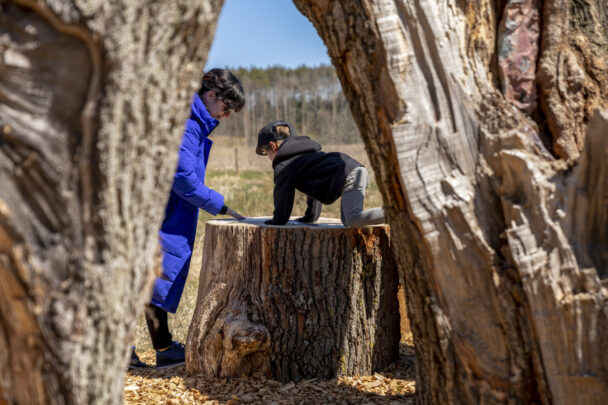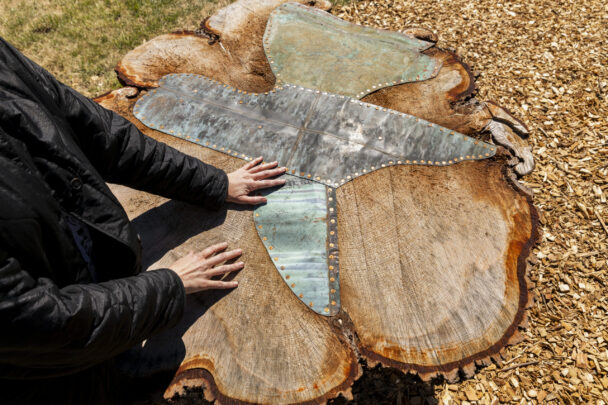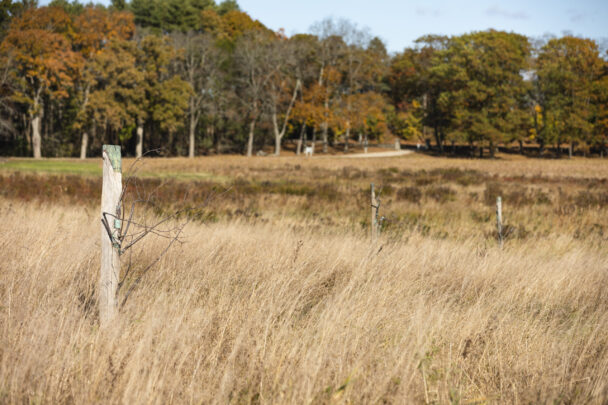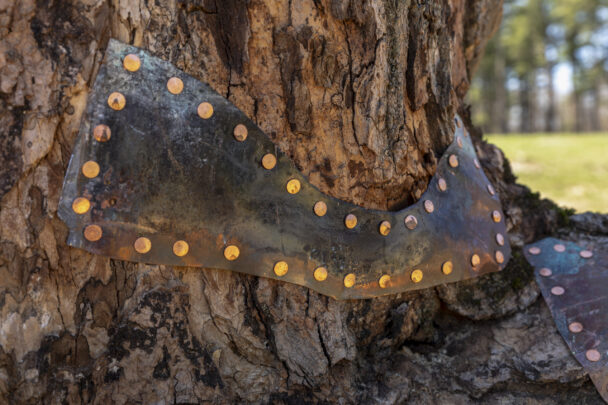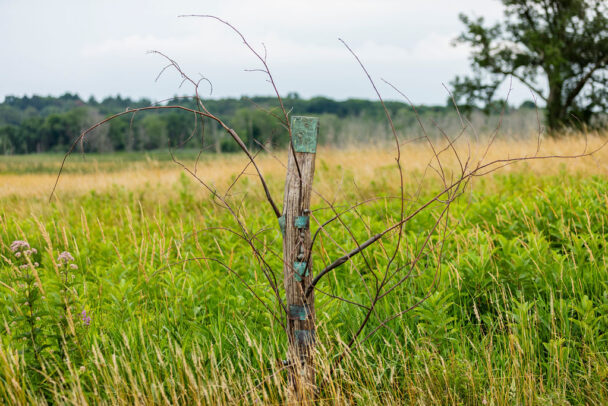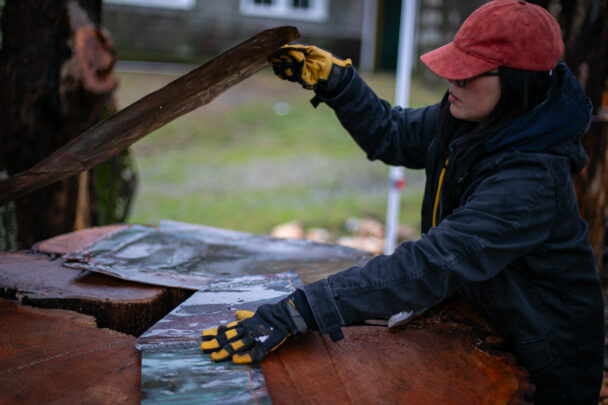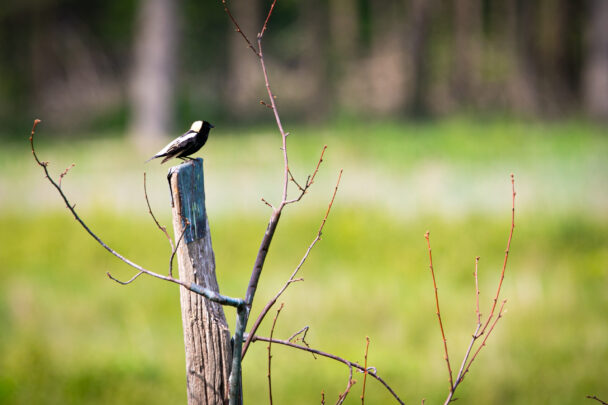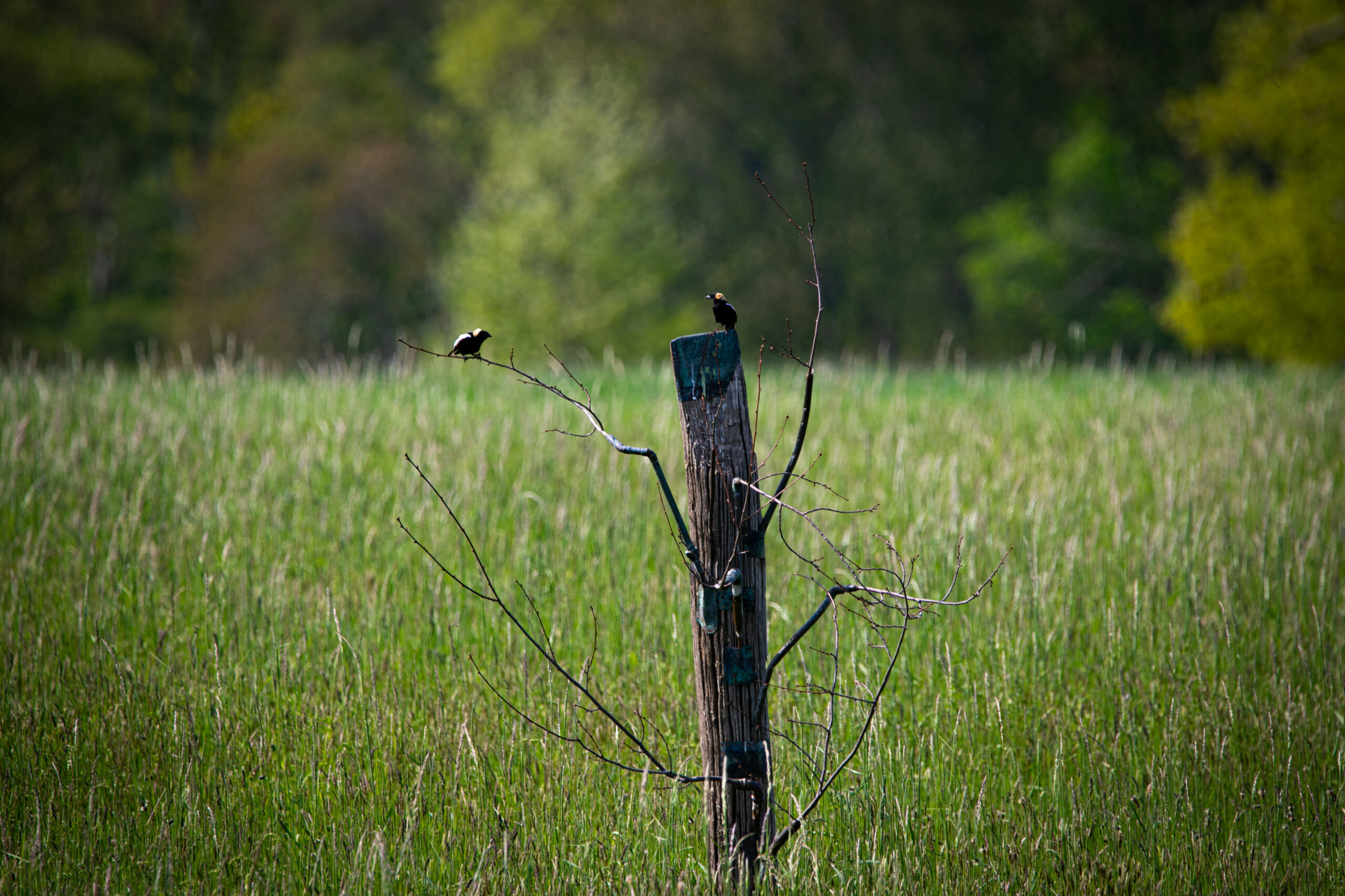

With Appleton Farms’ storied history and current ecological and agricultural activities, Jean Shin’s Perch explores temporality (ecological and agricultural time) and regeneration. Download this map to follow the Perch route and discover specific viewing sites. Click here for upcoming exhibition events.
Farm Admissions
| The Artist | About Bobolinks | Before You Go |
| Breeding Timeline | Grassland Habitat | Community Science |
At Appleton, bobolinks—songbirds who make the long migratory journey from the southern hemisphere and whose populations are in decline—are the primary birds that use the grasslands and hayfields as their nesting site.
Marking sites where the Trustees’ ecology team monitors the bobolink population, Shin presents sculptural platforms made from fallen and dead trees found throughout Appleton that visitors can engage with, as they ultimately become participants in this critical monitoring throughout the project’s run. Within the nesting area, Shin created sculptural perches made from fallen trees and salvaged copper in which male bobolinks can perch to search for mates and mark their territory.
Moreover, Jean Shin’s Perch integrates into the landscape and supports the agroecological work at the farm and is intended to visualize, amplify, and raise awareness around this critical species and its habitat as well as the important endeavors at Appleton Farms.
Jean Shin: Perch is organized by guest curator Jessica S. Hong in partnership with The Trustees and staff at its deCordova Sculpture Park and Museum, Lincoln, Massachusetts, as part of its Art & The Landscape initiative. Jessica Hong is the Senior Curator of Modern and Contemporary Art at the Toledo Museum of Art, Ohio.
Lead support for Art at The Trustees is provided by Arison Arts Foundation and Mr. Richard M. Coffman and Mrs. Gabrielle C.F. Coffman. This project is also supported by Marjorie D. and Nicholas P. Greville, Janet and David Offensend, Susan Denison, Pamela B. Weatherbee, Mr. Patrick J. and Mrs. Pamela C. Pedonti, Susan Denison, Debbie and Phil Edmundson, Kathleen O’Hara, and Valentine Talland and Nagesh Mahanthappa. We also thank Dan Mayer and Mayer Tree Service for their generous in-kind assistance.
Artwork Information
Jean Shin (b. 1971, Seoul, Korea, lives and works in Brooklyn and Hudson Valley, NY)
Perch, 2024
Local American chestnut from the wooden rails of a decommissioned fence at Appleton Farms; red oak, Norway maple, and sugar maple from dead and found trees at Appleton Farms; pruned branches from hybrid chestnuts at Chestnut Hill Farm and local American chestnuts with chestnut blight; salvaged copper from the community
Courtesy of the artist and Praise Shadows Art Gallery
About the Artist
Jean Shin (b. 1971, Seoul, Korea) is known for her expansive sculptures and installations confronting societal and ecological challenges. Her process is research-driven and participatory, engaging deeply with the materials she works with and the contexts in which she functions for each project. Shin salvages and transforms discarded objects—from mobile phones, and discarded commercial leather, to Mountain Dew soda bottles—into potent monuments that interrogate our complex relationship between material consumption, collective identity, and community engagement. Shin received her BFA in painting and MS in art history and criticism at the Pratt Institute. She has had solo presentations at The Museum of Modern Art, New York, Philadelphia Museum of Art, Smithsonian American Art Museum, Washington, DC, and the Asian Art Museum, San Francisco, and recently received the Frederic Church Award from the Olana Partnership for her contributions to American art and culture.
Get to Know our Feathered Friends in the Field – Bobolinks
Bobolinks are a grassland obligate bird species, meaning they are fully dependent on grassland habitat for survival – from feeding on insects and seeds to nesting on the ground in the cover of grasses. Each year, these impressive migratory songbirds travel nearly 12,500 miles to and from wintering grounds in southern South America and summer breeding grounds across the U.S. and southern Canada.
One of the most iconic and charismatic grassland birds, the bobolink is hard to miss. Males dress to impress in their summer breeding plumage. Many liken their white backs, black stomachs, and yellow nape to wearing a backward tuxedo. Females are much less conspicuous and more muted in color. Their pink bills, brown crown stripes, dusty yellow bellies, and dark brown streaked backs offer them the perfect camouflage with their grassy surroundings.
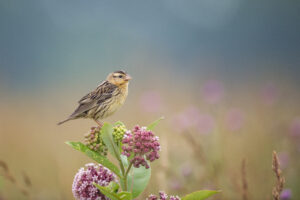
Perched female. Photo by PS50ACE.
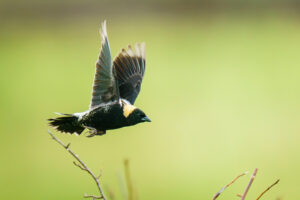
Male in flight. Photo by Mark Davis.
Before Setting Out
- Download this map to follow the Perch route and discover specific viewing sites.
- To protect the bobolink nesting area during your visit, we kindly ask you to remain on marked paths and view the sculpture perches from the designated platforms. Visitors may sit or stand on the sculptural platforms but do not climb. Please engage with care and at your own risk.
- Parking for Perch is available at the Appleton Farmhouse.
- To track your bird sightings, download the free app eBird Mobile.
Bobolink Breeding Season Timeline
Curious as to what the bobolinks are up to out in the field? Follow along this breeding season timeline to find out. (Dates are approximate and can vary slightly from year to year)
Second Week of May Male bobolinks have arrived at summer breeding grounds and are establishing territories.
- Watch males perform fight displays, rapidly beating their wings and flying in slow, looping arcs over their territory. You may also see males perching in the field, singing their electronic bubbling song.
- You may also notice males chasing other males across the field.
Third Week of May Female bobolinks have arrived, and mate paring begins.
- In addition to flight and song displays, males can also be seen chasing females.
Fourth Week of May Females construct nests and lay eggs.
- During nest construction, which typically takes 1-2 days, watch for females carrying nesting material.
- Females lay one egg per day and have a clutch size between 3-7 eggs. The eggs are pale bluish-gray to reddish brown, with irregular brown and lavender spots.
June Female bobolinks incubate eggs for approximately 11-14 days. Nestlings then hatch and remain in the nest for another 10-11 days.
- It becomes less common to spot females during egg incubation as they spend a lot of time sitting on their nests.
- Both male and female bobolinks feed nestlings. Throughout June, keep an eye out for bobolinks carrying food (insects) to their young.
First two weeks in July Young are fledging their nests and developing flight feathers.
- As the young fledge, nesting territories dissolve and bobolinks become more social and communal.
Late July-Early September All bobolinks begin flocking, molting, and preparing for migration back to wintering grounds.
- As the nesting season ends, bobolinks become much less territorial and begin to congregate in large flocks.
- Juvenile bobolinks are nearly impossible to tell apart from females as they share almost identical coloration.
- While both males and females molt, the molting males will shed their breeding plumage and begin to develop coloration closer to females. During this molting stage, males appear splotchy in color.
Grassland Habitat in New England
Habitat loss across breeding grounds is the primary driver of grassland bird population declines. Today, nearly 60% of native grasslands in the U.S. have been lost or severely degraded. This loss has put increasing importance on conserving the remaining grassland habitat here in New England, most of which is found within the agricultural landscape.
At Appleton Farms, we are working to balance grassland habitat management to support both grassland birds and local agriculture. These are often two conflicting priorities. While grassland habitat requires some form of active management to remain open, the timing of management events is key to bobolink nesting success. In fields dedicated solely to supporting bobolinks, grazing, mowing, or haying are delayed until July 15th, if not later, allowing for young to fledge and develop flight feathers. However, this does not allow farmers to sustain livestock or take the first cut of hay off the field, which is highest in nutrients. We seek to find solutions to these barriers through community science and agroecological initiatives (integrating ecological concepts and principles into farming). Through our community science program, we can assess which fields support grassland birds. In fields that can support grassland birds we can implement a delayed mowing management regime, while in those that do not exhibit the right characteristics for grassland birds, we can be more lenient in the timing of management. In fields that support grassland birds but are also necessary for hay/livestock, our agroecologist conducts careful bobolink nest monitoring and works with our farmers to design and outline rotational grazing and mowing regiments.
Community Science Program
Grassland birds have experienced the largest bird declines of any terrestrial biome! Two-thirds of grassland bird species have felt these effects, with 25% having reached their tipping point. Birds that have reached a tipping point are defined as having lost roughly two-thirds of their populations in the past 50 years and are on track to lose another 50% in the next 50 years. Bobolinks are one of these species, with population numbers on North American breeding grounds declining by over 60% since the 1970s.
In recognition of this decline, The Trustees launched a Community Science Grassland Bird Monitoring Program in 2010. Now entering its 14th year, a dedicated group of 70 volunteers conduct point count surveys across 1,000 acres of grassland habitat during the breeding season to help determine what properties support grassland species, what bird species are using Trustees grasslands, the relative abundance of each species, and if possible, determine if grassland birds are breeding and nesting successfully. The data volunteers collect also helps us evaluate if the current grassland habitat management regime is supporting grassland birds.
If you are interested in participating in The Trustees’ bird monitoring or other ecology programs, please visit The Trustees’ Volunteer page to view all current volunteer opportunities. Please note, new opportunities are posted regularly throughout the year. Please check back frequently.
We would like to acknowledge those involved in the presentation of Perch, including colleagues across The Trustees and external contributors:
-
- Mollie Armstrong
- Julio Aguilar
- JoJo Brennan
- Alejandro Brambila
- Sarah Cassell
- Yng-Ru Chen and Praise Shadows Art Gallery
- Tali Cherizli
- Doug Cook, Northeast Organic Farming Association, Massachusetts chapter
- Chris Costello
- Lieza Dagher
- JJ Desmond
- Mary Dettloff
- Clarissa Fostel
- Renée Gannon
- Rachel Gee
- Jane Hammer
- Ellie Harbeck
- Nicky Howard-Roger
- Gina Janovitz
- Meaghan Lawton
- Erik Levy, Save That Stuff
- Mark Lindsey
- Tess Lukey
- Zoë MacKay
- Jessica May
- Dan Mayer, Mayer Tree Service
- Sarah Montross
- Nick Mullin
- Maddie Nelson
- Ross Normandin
- Andrew Padilla
- Lindsey Parker
- EJ O’Sullivan and Cesar Desousa, Haven Contracting
- Julie Richburg
- Tyler Ripel
- Ryan Sailors
- Catherine Shortliffe
- Kristen Swanberg
- Denise Trapani
- Wayne Wilkins
- Ben Wise
